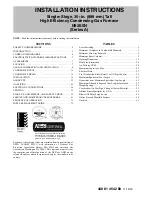
W415-2159 / D / 11.24.17
47
IOM
18.0 AIR
FLOW
18.1 TEMPERATURE RISE CHECK
H22.0
For proper furnace operation, air
fl
ow over the heat exchanger is of utmost importance. Insuf
fi
cient air
fl
ow
accelerates metal fatigue and possible failure in the heat exchanger, as well as decrease ef
fi
ciency. Excessive
air
fl
ow promotes accelerated corrosion of the heat exchanger.
IMPORTANT:
DO NOT BYPASS THIS STEP OF THE
START UP PROCEDURES.
Model
Delta T
NEV040T2A
35-65°F (20-36°C)
NEV060T3A
40-70°F (22.2-38.9°C)
NEV080T3A
NEV080T4A
NEV100T5A
NEV120T5A
H12.15.6A
TABLE 1 - RANGE OF TEMPERTURE RISE
When the duct system is complete and the air
fi
lter or
fi
lters are in place, determine if the air
fl
ow is correct for both
low and high
fi
re input rates.
1. Insert a duct thermometer in the supply air duct. The thermometer should be placed as close as practical
to the furnace, but out of the “line of sight” of the heat exchanger (this prevents false readings owing to
radiant heat). Ensure that the thermometer location is within the duct air stream. Avoid locations such as
the inside radius of an elbow, etc.
2. Insert a duct thermometer in the return air duct as close to the furnace as practical. Ensure that the
thermometer location will be unaffected by humidi
fi
er bypass ducts, etc. Choose a location well within the
main air stream.
3. Operate the furnace long enough to obtain steady state conditions at both input rates (High Fire and Low Fire).
4. When the two thermometers have stabilized, usually within 5-8 minutes, compare the two readings.
Subtract the return air temperature from the supply air temperature. The difference is the temperature rise,
also called
∆
T.
5. Compare the measured
∆
T to the temperature rise range shown on the rating plate.
When adjusting the temperature rise, the ideal temperature is approximately mid-range on the rating plate.
If the measured
∆
T is above the approved temperature range, there is too little air
fl
ow. It must be increased
by selecting the appropriate “HEAT” jumper setting, removing restrictions in the ductwork, or adding supply or
return ductwork.
If the measured
∆
T is too low, there is too much air
fl
ow.
H22.1.4
18.2 CALCULATING AIR FLOW
H22.2.2B
CFM =
Output
1.085 x
∆
T
where:
• CFM is air
fl
ow in cubic feet per minute;
•
∆
T is the temperature rise; and
• O
utput is the furnace output capacity
from the rating plate
.
There are circumstances where it may be desirable to know the air
fl
ow delivery through the duct system,
such as when estimating the amount of air
fl
ow available for
air conditioning. This can be done by direct measurement with
electronic or sloped manometers and velometers, or by counting
the number of times the Amber CFM LED on the control board
fl
ashes when equipped with ECM EON motor. Each
fl
ash
signi
fi
es 100 CFM; count the
fl
ashes and multiply by 100 to
determine the actual CFM delivered (for example: 10
fl
ashes x
100 = 1000 CFM), or use the formula in the next column.
Содержание 9600E E-STAR Series
Страница 27: ...W415 2159 D 11 24 17 27 IOM FIGURE 14A DIRECT VENT TERMINAL CLEARANCES...
Страница 28: ...W415 2159 D 11 24 17 28 IOM IOM FIGURE 14B NON DIRECT VENT TERMINAL CLEARANCES...
Страница 57: ...W415 2159 D 11 24 17 57 IOM 23 0 SERVICE HISTORY 43 1...
Страница 58: ...W415 2159 D 11 24 17 58 IOM IOM 24 0 NOTES 44 1...
Страница 74: ...6 0 NOTES 44 1 W415 2159 D 11 24 17 UM 74...
Страница 75: ...44 1 W415 2159 D 11 24 17 UM 75...
















































